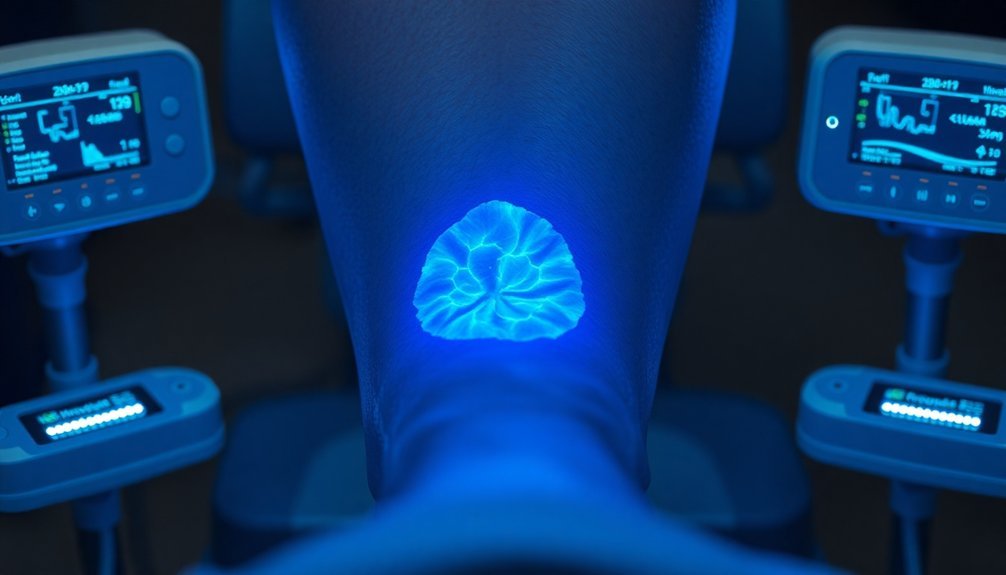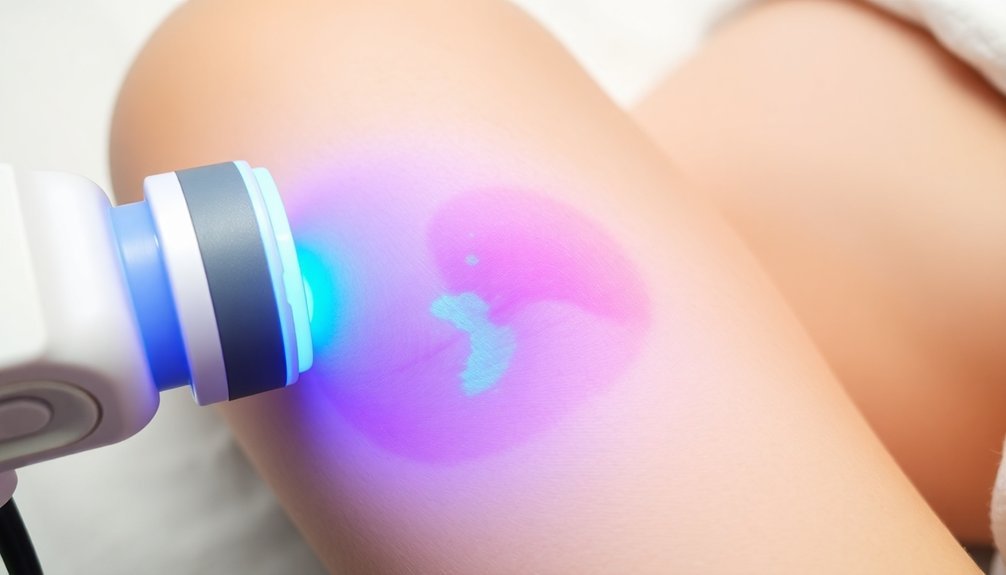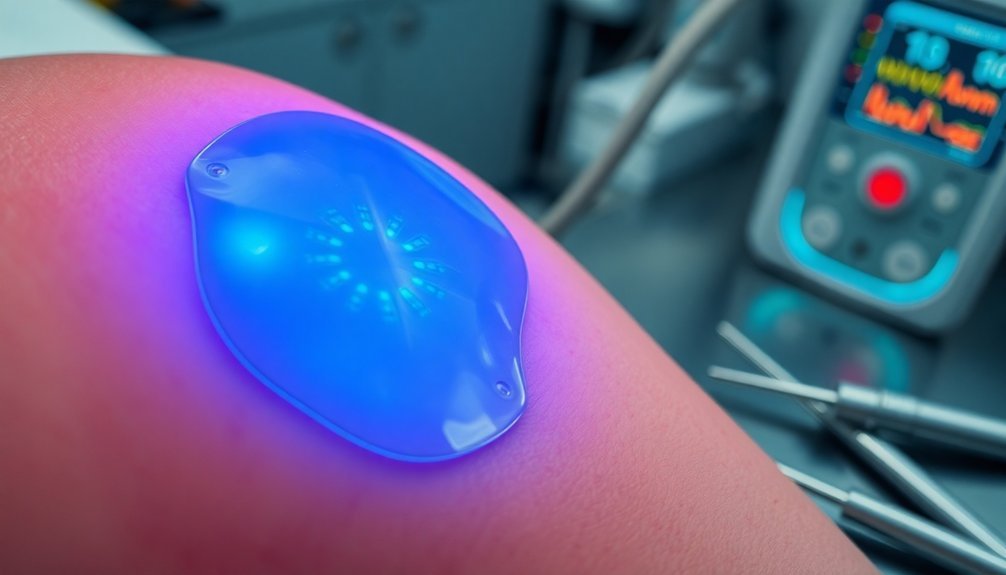Breakthrough Therapy designation can substantially accelerate the development of treatments for serious injuries by reducing FDA review time from 10 to 6 months. If you're following emerging treatments for severe injuries, you'll want to know that this special FDA status helps promising therapies reach patients faster through expedited trials and intensive FDA guidance. Scientists must show substantial clinical evidence that their treatment works better than existing options for life-threatening conditions. The designation has already helped speed up numerous medical advances, with 587 therapies granted this status since the program began. The innovative treatments emerging through this pathway could transform how we heal from major injuries.
Understanding Breakthrough Therapy Designation

Breakthrough Therapy designation steps up the pace of drug development for patients facing serious or life-threatening conditions. When a drug shows substantial improvement over existing treatments in preliminary clinical trials, it can qualify for this special FDA designation that helps expedite its development and review process.
You'll find that drugs receiving this designation must meet specific criteria. They need to target serious conditions and demonstrate significant advantages over current therapies through clinical evidence. This improvement can be shown through surrogate endpoints or biomarkers that strongly indicate clinical benefit. The designation provides cross-disciplinary review with experienced FDA staff members to optimize development.
If you're a drug developer seeking this designation, you'll need to submit a formal request to the FDA as an IND amendment. The FDA will respond within 60 days, and if approved, you'll receive intensive guidance from senior managers throughout the development process.
You should submit your request before the end-of-phase-2 meeting to maximize benefits.
While this designation doesn't guarantee approval, it opens doors to expedited processes like rolling reviews and priority review status. The FDA may rescind the designation if later data doesn't support the initial promise of substantial improvement.
Transforming Spinal Cord Treatment
Revolutionizing spinal cord injury treatment has taken a major leap forward with multiple groundbreaking therapies showing remarkable promise. You'll find non-invasive spinal stimulation leading the charge, with ONWARD Medical's Up-LIFT trial demonstrating impressive 72-90% response rates in improving upper limb mobility for tetraplegic patients. These advancements have shown no adverse effects beyond what was anticipated in clinical trials.
Stem cell therapy's making waves too, with Mayo Clinic's research showing safe, effective treatments using adipose-derived mesenchymal stem cells. They're seeing patients advance by entire AIS grades, marking significant functional improvements.
| Treatment Type | Success Rate | Timeline | Key Benefit | Status |
|---|---|---|---|---|
| Spinal Stimulation | 72-90% | Immediate | Upper limb function | FDA pending |
| Stem Cell Therapy | Significant | Months | AIS grade improvement | Clinical trials |
| Early Surgery | High | <24 hours | Better outcomes | Standard care |
| Ultra-early Surgery | Enhanced | <8 hours | Ideal recovery | Emerging |
| Neuro-scaffolds | Promising | Varied | Structural support | Trial phase |
You'll want to note that timing's vital – early surgical intervention within 24 hours dramatically improves outcomes. Even better results come from ultra-early surgery within 8 hours, combined with proper decompression and anatomic realignment.
Dancing Molecules For Nerve Repair

You'll find these remarkable dancing molecules create an intricate network of nanofibers that perfectly mimic your spinal cord's natural matrix, actively binding to cell receptors to trigger healing pathways.
The treatment's rapid healing timeline means you could see significant improvements within just four weeks, as demonstrated in studies where paralyzed mice regained their ability to walk.
Through this molecular regeneration process, you'll benefit from the formation of new blood vessels, reduced scar tissue, and the critical reformation of myelin around nerve cells, all working together to restore function.
This innovative therapy has shown great versatility, with researchers discovering its potential to help regenerate tissues in heart and liver conditions as well.
Molecular Regeneration Process
Modern molecular regeneration harnesses the power of 'dancing molecules' – specialized peptide amphiphile supramolecular polymers that form bioactive scaffolds to repair damaged nerves. When you look at how these molecules work, you'll see they create nanofibers that enhance the movement of signaling peptides, making them more effective at attaching to cell receptors.
The process begins when these molecules form fibrin cables across the injury gap. These cables serve as highways for Schwann cells to migrate and align themselves, creating structures called Bands of Bungner. This regenerative process can achieve growth rates of 1-3 millimeters per day under optimal conditions.
Schwann cells play a vital role – they multiply rapidly and release essential growth factors that drive nerve regeneration.
What makes this therapy particularly effective is its dual-action approach. You're getting two simultaneous regenerative pathways: one that stimulates nerve cell growth directly, and another that supports the development of blood vessels and other supporting tissues.
The treatment's already showing promising results in clinical trials, where it's helped repair nerve damage and improve both sensation and mobility. You'll be interested to know that researchers are now working to optimize these materials for FDA approval and broader clinical applications.
Rapid Healing Timeline
These remarkable "dancing molecules" demonstrate unprecedented healing speeds in nerve repair applications. You'll find the most striking evidence in mouse studies, where paralyzed subjects regained their ability to walk after just a single injection over a four-week period.
The molecules target critical TGFb-1 receptors for optimal tissue regeneration. The therapy's speed isn't limited to animal models – it's shown impressive results in human clinical trials for nerve damage repair, improving both sensations and mobility.
You can see the therapy's rapid action in cartilage regeneration, where significant progress occurs within just four hours, with continued development over three days. What's particularly significant is how the molecules accelerate spinal cord repair by enhancing signaling peptide movement, triggering important regeneration pathways.
You won't need to worry about long-term material buildup either, as the components naturally biodegrade into nutrients within 12 weeks.
The therapy's efficiency stems from its enhanced molecular motion, which speeds up cell signaling and activates regeneration pathways quickly. You'll find it doesn't just repair tissue – it also reduces scar formation, reforms myelin around axons, and creates functional blood vessels to nourish the healing area.
NTX-001 Clinical Trial Progress
You'll find the NTX-001 clinical studies have reached a pivotal point, with Phase Two results showing significant improvements in peripheral nerve function and pain reduction at both 12 and 24 weeks post-treatment.
The therapy's success in Phase Two, enrolling 51 patients who demonstrated measurable functional recovery, has paved the way for an upcoming Phase Three trial launch. The research earned recognition as a Top 10 Best Paper at the 2024 ASSH Annual Meeting.
These promising outcomes suggest you could see faster nerve regeneration compared to standard care alone, marking a potential shift in how doctors treat peripheral nerve injuries.
Phase Three Trial Launch
After extensive Phase II success, NTX-001's Phase Three clinical trial is set to launch in early 2025 as a randomized, double-blind, placebo-controlled study. You'll see the trial build upon the NEUROFUSE study results, with researchers working closely with the FDA to finalize the study protocol.
The trial's progress has been accelerated thanks to both Breakthrough Therapy Designation in 2024 and Fast Track Designation granted in 2020. Early data showed lower adverse event rates compared to standard treatments.
Here's what you can expect from the Phase Three trial:
- Thorough evaluation of NTX-001's safety and efficacy compared to standard care in peripheral nerve injury treatment
- Assessment of the therapy's ability to speed up and enhance functional recovery in patients
- Measurement of the treatment's impact on reducing neuropathic pain levels
- Analysis of sensory function recovery rates throughout the 48-week study period
If successful, you'll witness a significant advancement in peripheral nerve injury treatment. The trial's results could reshape treatment protocols globally, offering new hope to patients suffering from these debilitating injuries.
The company's committed to rapidly advancing NTX-001's development to address this critical unmet medical need.
Notable Phase Two Results
Recent Phase Two results from the NEUROFUSE Study have demonstrated remarkable success for NTX-001 in treating peripheral nerve injuries. This multicenter, randomized trial showed statistically significant improvements in hand function when compared to standard surgical repair alone, as measured by the Michigan Hand Questionnaire at both 8 and 24 weeks.
What's particularly encouraging is that patients experienced notable pain reduction post-operation compared to standard care, while maintaining an excellent safety profile with no concerning findings. The treatment showed lower adverse event rates compared to standard care.
The drug-device combination's performance was so impressive that it earned FDA Breakthrough Therapy Designation, fast-tracking its development process.
The medical community has taken notice, with the interim results presentation at the 2024 American Society for Surgery of the Hand Annual Meeting receiving a Top 10 Best Paper designation.
You can expect to see the complete 48-week data at an upcoming scientific conference, which will provide even more insight into NTX-001's long-term effectiveness. This novel approach to nerve repair represents a significant advancement in treating these devastating injuries, offering hope for faster and more complete recovery for patients requiring peripheral nerve repair.
Peripheral Nerve Recovery Timeline
The breakthrough timeline of NTX-001's peripheral nerve recovery shows remarkable acceleration compared to traditional treatments. You'll see substantial improvements in recovery speed and functional outcomes when comparing this innovative therapy to standard care procedures.
The clinical data reveals compelling evidence through both 8-week and 24-week measurements, with patients experiencing better healing trajectories.
Here's how the recovery timeline progresses with NTX-001:
- You'll notice immediate benefits in post-operative pain management, as patients report notably reduced discomfort compared to traditional treatments from the earliest stages.
- By week 8, you can observe marked improvements in MHQ Total Scores, indicating enhanced functional recovery.
- The 12-week mark reveals statistically notable advantages across multiple secondary endpoints, confirming the therapy's effectiveness.
- At 24 weeks, you'll find sustained improvements in functional outcomes, as presented at the 2024 ASSH Annual Meeting.
This accelerated recovery timeline represents a major advancement in treating peripheral nerve injuries, offering you hope for faster healing and better outcomes. NTX-001's ability to prevent Wallerian degeneration contributes directly to these improved recovery speeds, potentially transforming the standard treatment approach.
FDA Approval Fast Track

Through intensive efforts to accelerate groundbreaking treatments, FDA's Fast Track designation offers a streamlined pathway for promising therapies targeting serious conditions. You'll find that this expedited process reduces review time from 10 to 6 months while fostering enhanced collaboration between developers and regulators.
To qualify for Fast Track status, your treatment must address serious conditions, demonstrate significant improvement over existing therapies, and show preliminary clinical effectiveness. The process begins with a pre-IND meeting, followed by a formal request that the FDA reviews within 60 days.
| Fast Track Benefits | Requirements | Key Procedures |
|---|---|---|
| 6-month review | Serious condition | Pre-IND meeting |
| Rolling submissions | Unmet medical need | Formal request |
| Enhanced communication | Clinical evidence | 60-day review |
| Regular meetings | Development plan | Progress updates |
| Breakthrough potential | Safety data | Post-market monitoring |
While Fast Track designation expedites promising treatments, you must carefully balance speed with thoroughness. Remember that this pathway may require higher evidentiary standards and post-marketing surveillance to guarantee long-term safety and efficacy of your breakthrough therapy.
Patient Benefits From Expedited Development
Patients battling serious medical conditions stand to gain substantially from expedited drug development programs. These accelerated pathways provide faster access to potentially life-saving treatments, especially when you're dealing with severe illnesses where traditional therapies aren't effective.
The expedited development process delivers several key benefits that directly impact your healthcare options:
- You'll get earlier access to groundbreaking treatments through Fast Track and Accelerated Approval pathways, which can be vital when time is of the essence.
- You'll have more treatment choices as these programs bring innovative therapies to market, particularly in areas like oncology and infectious diseases.
- You'll benefit from targeted therapies that are specifically designed for your condition, often with improved safety profiles compared to existing treatments.
- You're likely to experience better health outcomes, as evidenced by higher Quality-Adjusted Life-Year gains in drugs approved through expedited programs.
When you're facing a serious medical condition, these benefits can make a significant difference in your treatment journey. The expedited programs guarantee you don't have to wait unnecessarily long for promising new therapies while maintaining essential safety standards.
Current Research Milestones

Recent research milestones have revealed promising therapeutic approaches for treating traumatic injuries. Etanercept research is leading the way, demonstrating favorable results in both animal models and human studies for traumatic brain injury (TBI). This treatment effectively reduces microglial activation, which plays a vital role in managing post-TBI neuroinflammation.
You'll also want to note the breakthrough in dancing molecules therapy, which has shown remarkable speed in promoting healing. Within just four hours, this treatment activates gene expression for cartilage regeneration, and by day three, it's already inducing essential protein components. The therapy's efficiency increases with molecular motion, making it particularly promising for spinal cord injuries and potential cartilage restoration.
Since 2010, INR's research on etanercept has achieved significant progress, while the FDA's Breakthrough Therapy designation has streamlined the development process for serious conditions. When you look at the designation requirements, you'll see they demand preliminary clinical evidence showing substantial improvement over existing treatments.
These developments represent critical steps forward in treating traumatic injuries, with researchers actively pursuing FDA approval for clinical trials.
Future Treatment Applications
Building on these research milestones, the dancing molecules therapy shows exceptional promise for multiple treatment applications. You'll find this groundbreaking treatment particularly exciting for spinal cord injuries, where it's already demonstrated the ability to repair tissue and reverse paralysis in mice by regenerating severed axons and reforming myelin.
The therapy's versatility extends beyond spinal injuries, with remarkable potential in several key areas:
- Cartilage regeneration, where human cells have shown activated gene expression within just four hours and produced essential proteins for repair within three days
- Bone regeneration studies, which are showing early positive results in pre-clinical testing
- Neurological conditions like ALS, Parkinson's, and Alzheimer's disease, where the therapy's ability to enhance cell signaling could prove beneficial
- Stroke recovery applications, utilizing the same principles of controlled molecular assemblies
You'll soon see this therapy advancing through FDA clinical trials, with researchers seeking Breakthrough Therapy Designation to expedite development.
The universal nature of the "supramolecular motion" principle means you might benefit from this technology in various medical treatments, as researchers continue optimizing these materials for human use.
Frequently Asked Questions
What Are the Potential Side Effects of Breakthrough Therapy Treatments?
You'll face risks like infection, blood clots, and allergic reactions. You might experience organ damage, chronic pain, or immune system problems. You're also at risk for cardiovascular issues and unpredictable psychological effects.
How Much Do Breakthrough Therapy Treatments Typically Cost?
You'll typically pay around $5,665 per month for breakthrough therapy treatments, which is higher than non-breakthrough options. However, they're often more cost-effective in the long run, averaging $38,000 per quality-adjusted life year.
Can Breakthrough Therapies Be Combined With Existing Traditional Treatments?
Yes, you can combine breakthrough therapies with traditional treatments. When properly integrated, they'll often work together to enhance treatment outcomes. The FDA specifically allows for these combinations to improve therapeutic results and patient care.
Are Breakthrough Therapy Treatments Covered by Insurance Companies?
Yes, you'll find many insurance companies cover breakthrough therapies, but coverage varies by plan. Medicare now offers immediate coverage through the MCIT Pathway, while private insurers set their own coverage policies and requirements.
How Long Does the Average Breakthrough Therapy Treatment Take to Complete?
You'll typically complete breakthrough therapy treatments in about 4.8 years, which is substantially faster than traditional treatments that take 8 years. It's shorter because of expedited development and priority review processes.
In Summary
You're witnessing a revolutionary moment in medical science with this breakthrough therapy. As dancing molecules repair nerve damage and speed healing, you'll see more patients regain mobility faster than ever before. The FDA's fast-track approval means you won't have to wait long for these treatments to become widely available. Keep watching as this therapy transforms spinal cord treatment and opens doors for future healing applications.





Leave a Reply